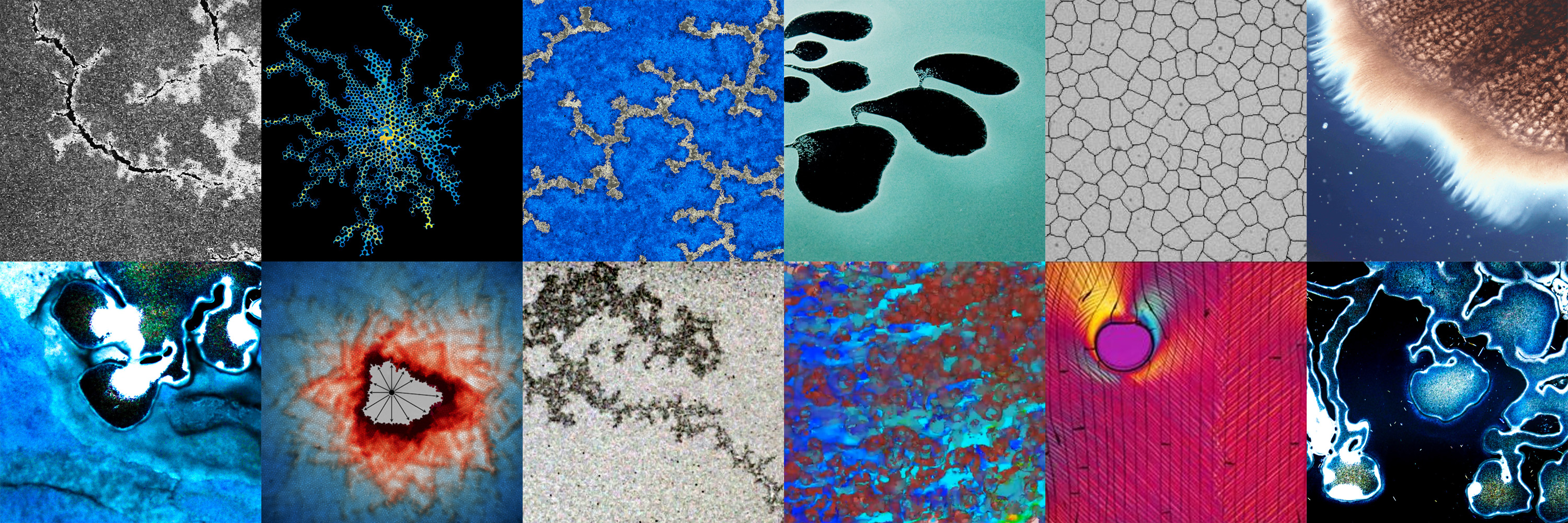Flow, deformation, and reaction patterns in porous media
Description
We seek to understand, predict and eventually control the patterns that emerge in porous and granular materials by fluid flow. Examples include the creation of flow-induced preferential conduits (fingers or channels) by hydrodynamic instabilities, fracturing, dissolution and deposition of solutes and particles. The acquired knowledge would be applied to a range of applications, ranging from 3-D printing, coating, microfluidics, and filtering to water resources, carbon geo-sequestration, sediment erosion and enhanced energy recovery.
Join SIG Mailing list
Members
L = leader; C = co-leader; * = Other key personnel
| [L] | Ran Holtzman ( Coventry University ): ran.holtzman@coventry.ac.uk |
| [C] | Bjornar Sandnes ( Swansea University ): b.sandnes@swansea.ac.uk |
| Matteo Icardi ( University of Nottingham ): | |
| Lucas Goehring ( Nottingham Trent University ): | |
| Chris MacMinn ( University of Oxford ): | |
| Seyed Shariatipour ( Coventry University ): | |
| James Jewkes ( Coventry University ): | |
| Svetlana Aleksandrova ( University of Leicester ): | |
| Humberto Medina ( University of Nottingham ): | |
| Chenfeng Li ( Swansea University ): | |
| Richard Katz ( University of Oxford ): | |
| Andrew Wells ( University of Oxford ): | |
| Petr Denissenko ( University of Warwick ): | |
| Peter J. Thomas ( University of Warwick ): | |
| James Sprittles ( University of Warwick ): | |
| Mohaddeseh Mousavi Nezhad ( University of Warwick ): | |
| Florian Doster ( Heriot-Watt University ): | |
| Rink van Dijke | |
| Kamaljit Singh ( Heriot-Watt University ): | |
| Alexandra Tzella ( University of Birmingham ): | |
| Vahid Niasar ( University of Manchester ): | |
| Martin Blunt ( Imperial College London ): | |
| Branko Bijeljic ( Imperial College London ): | |
| Duncan Hewitt ( University College London ): | |
| Yukie Tanino ( University of Aberdeen ): | |
| Igor Chernyavsky ( University of Manchester ): | |
| Herbert Huppert ( University of Cambridge ): | |
| Hayley Vosper ( British Geological Survey ): | |
| William ('Mack') Durham ( University of Sheffield ): | |
| Anne Juel ( University of Manchester ): | |
| Jyoti Phirani ( University of Strathclyde ): | |
| Andrew Kilpatrick ( British Geological Survey ): | |
| Chris Rochelle ( British Geological Survey ): | |
| Miles Morgan ( Swansea University ): | |
| Odd Andersen ( SINTEF Digital ): | |
| Eric Mackay ( Heriot-Watt University ): | |
| Susan Fellows ( Computer Modelling Group (CMG) ): | |
| Marco Misenta ( Computer Modelling Group (CMG) ): | |
| Anusuya Pal ( University of Warwick ): | |
| Subhadeep Roy ( Birla Institute of Technology & Science Pilani (Hyderabad Campus) ): | |
| Alexandros Kontogiannis ( University of Cambridge ): | |
| Ali Saeibehrouzi ( University of Warwick; Coventry University ): | |
| Sotiria Kogou ( Nottingham Trent University ): | |
| david thickett | |
| Haida Liang ( Nottingham Trent University ): |
Special collection in Frontiers on "Nonequilibrium Multiphase and Reactive Flows in Porous and Granular Materials"
We are inviting contributions for a special collection on "Nonequilibrium Multiphase and Reactive Flows in Porous and Granular Materials", a joint publication by Frontiers in Water and Frontiers in Physics.
Details and submission here (deadline and APC are flexible ;). Editors:
- Ran Holtzman, Fluids and Complex Systems Research Centre, Coventry University, UK
- Matteo Iccardi, School of Mathematical Sciences, University of Nottingham, UK
- Bjornar Sandnes, Chemical Engineering, Swansea University, UK
- Ramon Planet, Física de la Matèria Condensada, Universitat de Barcelona, Spain
- Marcel Moura, Department of Physics, University of Oslo, Norway
Elaborated Description
We seek to gather an interdisciplinary research community, and develop novel ideas to understand, predict and eventually control the patterns that emerge in porous and granular materials by fluid flow. Examples include:
i) preferential flow pathways induced by mechanical and/or chemical modifications of the solid matrix such as fracturing and dissolution;
ii) fluid fingers associated with microstructural heterogeneity and hydrodynamic instabilities;
iii) Thermo/turbophoresis, precipitation, and deposition of solutes and particles in channels and porous structures.
In these phenomena, coupling of fluid flow and fluid-fluid or fluid-solid interactions leads to highly focused flow and deformation, which, on top of producing enchanting patterns also provide enhanced migration pathways for mass and heat and alter the mechanical and chemical state of these materials. Relevant applications include many natural and industrial processes which span a wide range of scales, from 3-D printing, coating, microfluidics, filtering, and combustion to geophysical processes such as subsurface contamination and remediation, hazardous waste storage, carbon geo-sequestration, sediment erosion and enhanced recovery of oil, gas and geothermal energy.
This SIG will provide a platform to bring together scientists with various experimental, theoretical and numerical expertise from diverse fields including fluid mechanics, earth sciences, soil mechanics, civil and mechanical engineering, mathematics and physics. Together, we will tackle some of the most burning challenges related to processes in which fluid flow patterning is key. A spacial focus will be given to environmental and energy applications involving fluid injection and transport of fluids and solutes in the subsurface, with the aim of transferring the methodologies in this field to other areas cited above.
Inaugural meeting 9/1/2020 in Coventry University!
When/what: 9/1/20 10:30-16:30, Swan Room, Elm Bank, CV12NL Coventry. For program see https://fluids.ac.uk/files/sig/kickoff_meeting_program.1578478454.pdf
Where: https://fluids.ac.uk/files/sig/kickoff_meeting_Coventry_arrival_instructions.1578478478.pdf
Registration in https://forms.gle/dbqiWaUsGp3MRNy66
